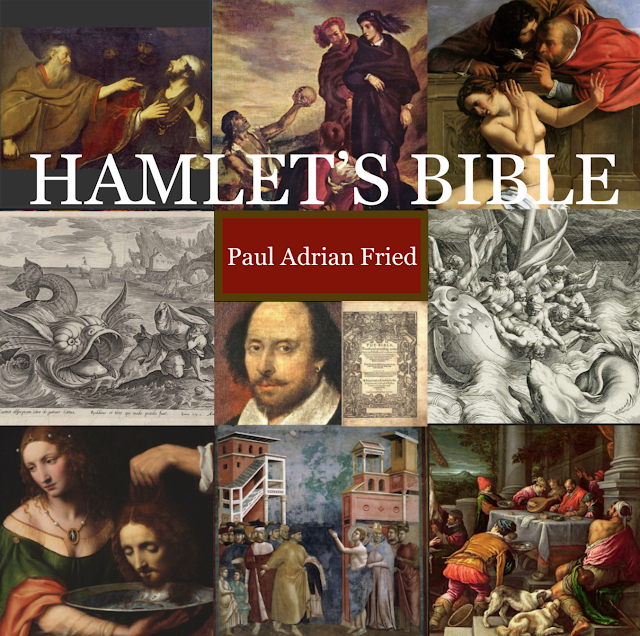EMMAUS IN MERCHANT OF VENICE
EMMAUS IN MERCHANT OF VENICE
In THE MERCHANT OF VENICE, one can find a surprising variation on EMMAUS:
The biblical tale of the disciples on the road to Emmaus is structured like this:
1. A mentor (Jesus) suffers (crucifixion & death).
2. Disciples on the road are troubled by all of this.
3. They meet a stranger they do not recognize
who comforts them and explains things (scripture).
4. A physical sign (breaking bread) reveals the stranger’s identity (Jesus).
In Merchant of Venice, a twist:
1. Mentor Antonio suffers apparent financial losses & threat of death
(many scholars view him as a Christ-figure).
2. Bassiano & Gratiano are troubled and go to Venice (to save Antonio
with Portia’s money).
3. They meet a stranger (Portia disguised)
who explains mercy, salvation, & law to the court, and saves Antonio.
4. Bassanio & Gratiano reluctantly give their wedding rings as signs of gratitude, breaking their ring-vows instead of bread.
Physical signs (rings) later help reveal the strangers’ identities.
These are wonderful variations on the Emmaus formula:
They highlight that [although Bassanio and Gratiano are like disciples of Antonio,]
Antonio is not the disguised Christ figure; Portia is!
The sacrament which is key to recognizing *this* divine stranger
is marriage, with vows and rings, not Eucharist with breaking bread.
~~~~~~~~~~~~~~~~~~~~~~~~~~~~~~~~~~~~~~~~~~~
[Originally posted around the week of 5/7/18
on LinkedIn]
~~~~~
OTHER POSTS IN THIS SERIES:
INTRODUCTION: “Emmaus in Hamlet,” 21 May, 2018:
https://pauladrianfried.blogspot.com/2018/05/emmaus-in-hamlet-in-emmaus-story-1.html
"Emmaus in Merchant of Venice," 7 May, 2018:
https://pauladrianfried.blogspot.com/2019/01/emmaus-in-merchant-of-venice-in.html
1. Blasphemy in Hamlet 5.1 Emmaus figures: Part 1
https://pauladrianfried.blogspot.com/2022/05/blasphemy-and-heresy-in-hamlets-emmaus.html
2. Heresy in Hamlet 5.1 Emmaus figures: Part 2
https://pauladrianfried.blogspot.com/2022/05/heresy-in-hamlet-51-emmaus-figures-part.html
3. From Fear & Power to Fools & Affection (Emmaus in Hamlet 5.1, Part 3)
https://pauladrianfried.blogspot.com/2022/05/from-fear-power-to-fools-affection.html
4. Why Rhenish, not Bread? Emmaus in Hamlet 5.1, Part 4
https://pauladrianfried.blogspot.com/2022/05/why-rhenish-not-bread-emmaus-in-hamlet.html
5. Hamlet, Emmaus, Eucharistic Controversy, and Semiotics: Part 5
https://pauladrianfried.blogspot.com/2022/05/hamlet-emmaus-eucharistic-controversy.html
6. Emmaus Key Change in Hamlet & Merchant of Venice (Emmaus in Hamlet, part 6)
https://pauladrianfried.blogspot.com/2022/05/emmaus-key-change-in-hamlet-merchant-of.html
~~~~~~~~~~~~~~~~~~~~~~~~
Disclaimer: If and when I quote or paraphrase bible passages or mention religion in many of my blog posts, I do not intend to promote any religion over another, nor am I attempting to promote religious belief in general; only to explore how the Bible and religion influenced Shakespeare, his plays, and his age.
~~~~~~~~~~~~~~~~~~~~~~~~
~~~~~~~~~~~~~~~~~~~~~~~~~~~~~~~~~~~~~~
Thanks for reading!
~~~~~~~~~~~~~~~~~~~~~~~~~~~~~~~~~~~~~~
My current project is a book tentatively titled Hamlet’s Bible, about biblical allusions and plot echoes in Hamlet.
Below is a link to a list of some of my top posts (“greatest hits”), including a description of my book project (last item on the list):
https://pauladrianfried.blogspot.com/2019/12/top-20-hamlet-bible-posts.html
I post every week, so please visit as often as you like and consider subscribing.

In THE MERCHANT OF VENICE, one can find a surprising variation on EMMAUS:
The biblical tale of the disciples on the road to Emmaus is structured like this:
1. A mentor (Jesus) suffers (crucifixion & death).
2. Disciples on the road are troubled by all of this.
3. They meet a stranger they do not recognize
who comforts them and explains things (scripture).
4. A physical sign (breaking bread) reveals the stranger’s identity (Jesus).
In Merchant of Venice, a twist:
1. Mentor Antonio suffers apparent financial losses & threat of death
(many scholars view him as a Christ-figure).
2. Bassiano & Gratiano are troubled and go to Venice (to save Antonio
with Portia’s money).
3. They meet a stranger (Portia disguised)
who explains mercy, salvation, & law to the court, and saves Antonio.
4. Bassanio & Gratiano reluctantly give their wedding rings as signs of gratitude, breaking their ring-vows instead of bread.
Physical signs (rings) later help reveal the strangers’ identities.
These are wonderful variations on the Emmaus formula:
They highlight that [although Bassanio and Gratiano are like disciples of Antonio,]
Antonio is not the disguised Christ figure; Portia is!
The sacrament which is key to recognizing *this* divine stranger
is marriage, with vows and rings, not Eucharist with breaking bread.
~~~~~~~~~~~~~~~~~~~~~~~~~~~~~~~~~~~~~~~~~~~
[Originally posted around the week of 5/7/18
on LinkedIn]
~~~~~
OTHER POSTS IN THIS SERIES:
INTRODUCTION: “Emmaus in Hamlet,” 21 May, 2018:
https://pauladrianfried.blogspot.com/2018/05/emmaus-in-hamlet-in-emmaus-story-1.html
"Emmaus in Merchant of Venice," 7 May, 2018:
https://pauladrianfried.blogspot.com/2019/01/emmaus-in-merchant-of-venice-in.html
1. Blasphemy in Hamlet 5.1 Emmaus figures: Part 1
https://pauladrianfried.blogspot.com/2022/05/blasphemy-and-heresy-in-hamlets-emmaus.html
2. Heresy in Hamlet 5.1 Emmaus figures: Part 2
https://pauladrianfried.blogspot.com/2022/05/heresy-in-hamlet-51-emmaus-figures-part.html
3. From Fear & Power to Fools & Affection (Emmaus in Hamlet 5.1, Part 3)
https://pauladrianfried.blogspot.com/2022/05/from-fear-power-to-fools-affection.html
4. Why Rhenish, not Bread? Emmaus in Hamlet 5.1, Part 4
https://pauladrianfried.blogspot.com/2022/05/why-rhenish-not-bread-emmaus-in-hamlet.html
5. Hamlet, Emmaus, Eucharistic Controversy, and Semiotics: Part 5
https://pauladrianfried.blogspot.com/2022/05/hamlet-emmaus-eucharistic-controversy.html
6. Emmaus Key Change in Hamlet & Merchant of Venice (Emmaus in Hamlet, part 6)
https://pauladrianfried.blogspot.com/2022/05/emmaus-key-change-in-hamlet-merchant-of.html
~~~~~~~~~~~~~~~~~~~~~~~~
Disclaimer: If and when I quote or paraphrase bible passages or mention religion in many of my blog posts, I do not intend to promote any religion over another, nor am I attempting to promote religious belief in general; only to explore how the Bible and religion influenced Shakespeare, his plays, and his age.
~~~~~~~~~~~~~~~~~~~~~~~~
~~~~~~~~~~~~~~~~~~~~~~~~~~~~~~~~~~~~~~
Thanks for reading!
~~~~~~~~~~~~~~~~~~~~~~~~~~~~~~~~~~~~~~
My current project is a book tentatively titled Hamlet’s Bible, about biblical allusions and plot echoes in Hamlet.
Below is a link to a list of some of my top posts (“greatest hits”), including a description of my book project (last item on the list):
https://pauladrianfried.blogspot.com/2019/12/top-20-hamlet-bible-posts.html
I post every week, so please visit as often as you like and consider subscribing.

Comments
Post a Comment